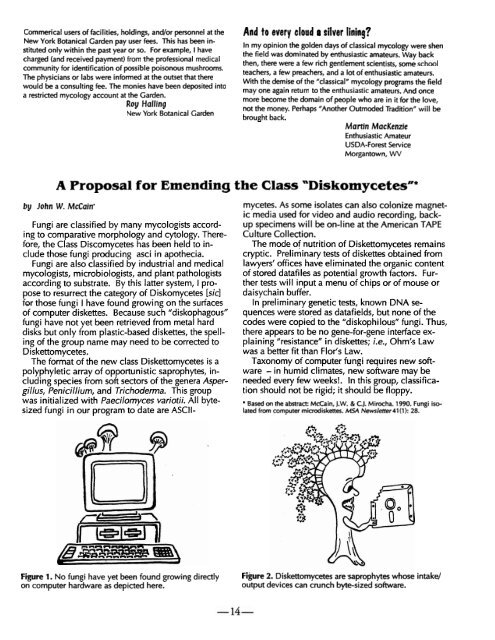1993 - Mycological Society of America
1993 - Mycological Society of America
1993 - Mycological Society of America
Create successful ePaper yourself
Turn your PDF publications into a flip-book with our unique Google optimized e-Paper software.
Commerical users <strong>of</strong> facilities, holdings, and/or personnel at the And to every cloud silver lining?<br />
New York Botanical Garden pay user fees. This has been instituted<br />
only within the past year or so. For example, I have<br />
charged (and received payment) the ~~~~~~~~~~~l<br />
community for identification <strong>of</strong> possible poisonous mushrooms.<br />
The physicians or labs were informed at the outset that there<br />
would be a consulting fee. The monies have been deposited into<br />
a restricted mycology account at the Garden.<br />
Roy Hulling<br />
New York Botanical Garden<br />
In my opinion the golden days <strong>of</strong> classical mycology were shen<br />
the field was dominated by enthusiastic amateurs. Way back<br />
then, there were a few rich gentlement scientim, some<br />
teachers, a few preachers, and a lot <strong>of</strong> enthusiastic amateurs.<br />
With the demise <strong>of</strong> the "classical" mycology programs the field<br />
may one again to the amateurs, And once<br />
more become the domain <strong>of</strong> people who are in it for the love,<br />
not the money. Perhaps "Another Outmoded Tradition" will be<br />
brought - back.<br />
Martin MacKenzie<br />
Enthusiastic Amateur<br />
USDA-Forest Service<br />
Morgantown, WV<br />
A Proposal for Emending the Class "Diskomycetes"*<br />
by John W. McCain'<br />
Fungi are classified by many mycologists accord-<br />
ing to comparative morphology and cytology. There-<br />
fore, the Class Discomycetes has been held to in-<br />
clude those fungi producing asci in apothecia.<br />
Fungi are also classified by industrial and medical<br />
mycologists, microbiologists, and plant pathologists<br />
according to substrate. By this latter system, I pro-<br />
pose to resurrect the category <strong>of</strong> Diskomycetes [sic]<br />
for those fungi I have found growing on the surfaces<br />
<strong>of</strong> computer diskettes. Because such "diskophagous"<br />
fungi have not yet been retrieved from metal hard<br />
disks but only from plastic-based diskettes, the spell-<br />
ing <strong>of</strong> the group name may need to be corrected to<br />
Di s kettomycetes.<br />
The format <strong>of</strong> the new class Diskettomycetes is a<br />
polyphyletic array <strong>of</strong> opportunistic saprophytes, in-<br />
cluding species from s<strong>of</strong>t sectors <strong>of</strong> the genera Asper-<br />
gillus, Penicillium, and Trichoderma. This group<br />
was initialized with Paecilomyces variotii. All byte-<br />
sized fungi in our program to date are ASCII-<br />
mycetes. As some isolates can also colonize magnet-<br />
ic media used for video and audio recording, back-<br />
up specimens will be on-line at the <strong>America</strong>n TAPE<br />
Culture Collection.<br />
The mode <strong>of</strong> nutrition <strong>of</strong> Diskettomycetes remains<br />
cryptic. Preliminary tests <strong>of</strong> diskettes obtained from<br />
lawyers' <strong>of</strong>fices have eliminated the organic content<br />
<strong>of</strong> stored datafiles as potential growth factors. Fur-<br />
ther tests will input a menu <strong>of</strong> chips or <strong>of</strong> mouse or<br />
daisychain buffer.<br />
In preliminary genetic tests, known DNA se-<br />
quences were stored as datafields, but none <strong>of</strong> the<br />
codes were copied to the "diskophilous" fungi. Thus,<br />
there appears to be no gene-for-gene interface ex-<br />
plaining "resistance" in diskettes; i.e., Ohm's Law<br />
was a better fit than Flor's Law.<br />
Taxonomy <strong>of</strong> computer fungi requires new s<strong>of</strong>t-<br />
ware - in humid climates, new s<strong>of</strong>tware may be<br />
needed every few weeks!. In this group, classifica-<br />
tion should not be rigid; it should be floppy.<br />
Based on the abstract: McCain, J.W. & C.J. Mirocha. 1990. Fungi iso-<br />
lated from computer miaodiskettes. MSA Newslefter41(1): 28.<br />
Figure 1. No fungi have yet been found growing directly Figure 2. Diskettomycetes aresaprophytes whose intake/<br />
on computer hardware as depicted here. output devices can crunch byte-sized s<strong>of</strong>tware.
















